Many pincers make light work
Los Amigos, a field station in southern Peru, run by the ACA is bristling with life. The lowland forest that surrounds the station is home to 11 species of monkey, jaguars, tapirs, hundreds of bird species and a dazzling variety of arthropods – my personal favourites.
One evening at the station, when I was out searching for insects and spiders, I was taking a close look at a rose-apple tree (Syzygium malaccense). If you take a good look at the trunk of almost any tree in the tropics you’ll be amazed by the variety of life that can be found. I was taking photos of some of the beautifully camouflaged spiders that press their flattened body to the bark to ambush prey when I noticed some spindly insect legs poking out from under a bit of flaking bark. I carefully pulled the insect out and it turned out to be the withered body of a small bush-cricket that had somehow meant an unfortunate end. I prised the bark away to reveal a group pf pseudoscorpions. Did these somehow capture and kill the cricket?
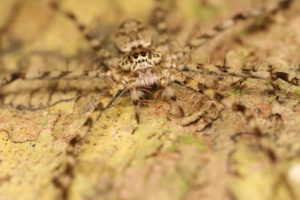
I looked at other bits of bark and before long had found many pseudoscorpions in discrete groups beneath every bit of suitable bark. Looking a bit harder I saw the open pincers of these animals poking out from underneath the bark. To see how they would react to potential prey I captured a leaf-cutter ant and placed it on the fissures where the open pincers were waiting. It wasn’t long before I saw how these tiny arachnids get their food. Detecting prey, the pincers become very active, snatching at any appendage that comes near until one clamps down on an antenna or leg. The owner of this pincer then retreats backwards to pin the limb before its relatives join in to restrain the struggling prey. Before long the prey, many times the size of an individual pseudoscorpion, is completely pinned or even dragged bodily into the pseudoscorpions’ lair. These fearsome little predators also appear to inject venom, which has the hallmarks of a potent neurotoxin, such as muscle spasms of the prey’s body.
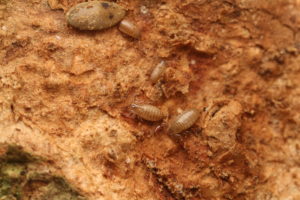
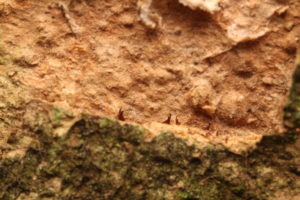
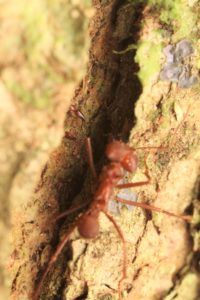
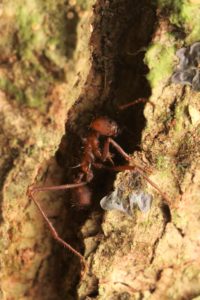
The next evening on the same tree I found a big leaf-cutter ant worker that had been captured by a group of pseudoscorpions, but it had not been dragged under the bark, laying the action bare. The pseudoscorpions were gathered around its head and limbs, apparently sucking it dry, probably from punctures in the thin arthrodial membrane between segments.
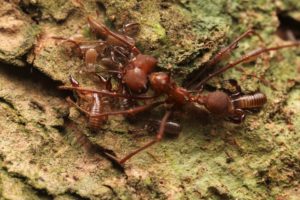
All of this amazed me and I had never heard about such behaviour, but it turns out something similar has been documented (see below). The species in these papers live in family groups composed of adults and juveniles. The pseudoscorpions snag and restrain the prey and the bigger juveniles bite the prey to deliver the venom. The whole group then feeds communally on the prey. Although these studies document the behaviour there are still loads of questions, such as what adaptations do the adults have for restraining their relatively powerful prey? Where do they envenomate the prey? What is the composition of the venom? How is feeding organised? We collected several of the pseudoscorpions in alcohol, formalin and RNA-later so we’ll be able to answer a few of these questions.
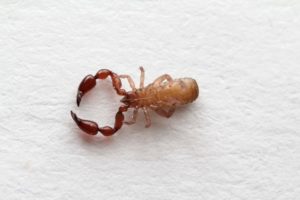
Here are some videos of the pseudoscorpions in action, first catching a large leaf-cutter ant worker and then a smaller ant that is quickly dragged bodily beneath the bark. Normally, the pseudoscorpions rely on prey blundering into their trap, but to get this footage we introduced prey to the gaps where we saw pseudoscorpion activity:
Further reading
Turk FA (1952). A new genus and species of pseudoscorpion with some notes on its biology. Proc. Zool. Soc. Lond.;122:951–954.
Brach V (1978). Social behavior in the pseudoscorpion Paratemnus elongatus (Banks) (Pseudoscorpionida: Atemnidae). Insectes Soc.;25, 3–11.
Zeh JA and Zeh DW (1990). Cooperative foraging for large prey by Paratemnus elongatus (Pseudoscorpionida, Atemnidae). The Journal of Arachnology;18(3):307-31.
Thanks to David Wilcockson, Karen Siu-Ting, Chris Creevey and the students of the Aberystwyth University Zoology field course for help getting the footage above.
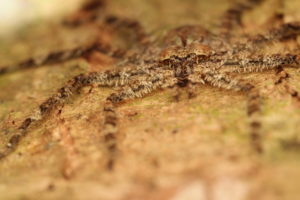
Leave a Reply